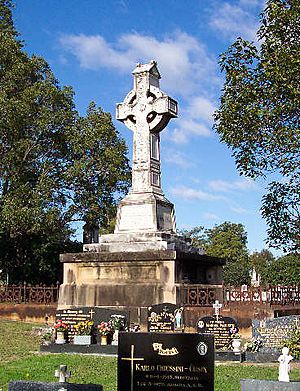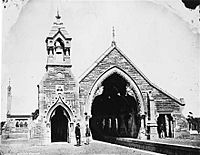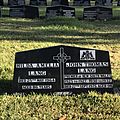Rookwood Cemetery facts for kids

Rookwood Necropolis entrance
|
|
| Details | |
|---|---|
| Established | 1868 |
| Location | |
| Country | Australia |
| Type | Public |
| Size | 286 hectares |
| No. of interments | 1 million |
Rookwood Cemetery is a very old and important cemetery in Rookwood, Sydney, New South Wales, Australia. Its official name is Rookwood Necropolis. It is the largest cemetery in the Southern Hemisphere. It is also the biggest working cemetery from the Victorian era still in use today. The cemetery is about 17 kilometres west of Sydney central business district. It was added to the New South Wales State Heritage Register in 1999 because of its history.
Contents
About Rookwood Cemetery
Rookwood Cemetery is a huge place. It is split into different areas for various religious groups. Each area used to have its own offices and staff. Today, three main groups manage the cemetery. The Rookwood Necropolis Land Manager looks after the land for the NSW Government.
Two other groups manage specific burial sections. These are the Rookwood General Cemeteries Reserve Land Manager and the Catholic Cemeteries and Crematoria. There is also the NSW Cremation Company. This company runs The Rookwood Memorial Gardens Crematorium. It is the oldest working crematorium in Australia.
Special Memorials and Shrines
Rookwood has several special memorial places. There are shrines for victims of the Holocaust. There are also memorials for sailors who died during wartime. The Sydney War Cemetery is in the eastern part of Rookwood. The Circle of Love is a special place for babies who died very young.
Size and Importance
By 2014, over 915,000 people had been buried or cremated at Rookwood. The cemetery covers about 314 hectares (776 acres). A group called "Friends of Rookwood Inc" helps to protect this important site. Rookwood is very important to Australia's history. It is the largest Victorian era cemetery still in use worldwide.
Plants and Nature
Some older parts of Rookwood are full of plants. You can find old garden plants and large trees. There are also native plants, including some rare ones. These include the Downy wattle and small leaved Dillwynia. This mix of plants makes the cemetery a unique natural area.
The Serpentine Canal in the Rookwood General Cemeteries Reserve was recently fixed up. This project improved the area with new plants and decorations.
History of the Cemetery
In 1819, Governor Lachlan Macquarie opened Sydney's first main burial ground. This was the Devonshire Street Cemetery. By the 1840s, it was almost full. Sydney needed a much bigger cemetery.
Choosing a New Location
People wanted new burial sites to be outside the city. This was for health reasons and to make them more peaceful. A railway line to Parramatta was finished in 1856. This made it possible to put the new cemetery along the train line.
In 1862, the government bought 80 hectares of land at Haslem's Creek. This land was chosen because it was far enough away from the city. It was also easy to reach by train.
Dividing the Land
The cemetery was then divided into sections. Each section was for a different religious group. The Church of England got 21 hectares. The Catholic Church got 14 hectares. A non-religious area of 23 hectares was also set up. Other groups like Jews, Presbyterians, and Wesleyans also received land.
The Necropolis Act of 1867 officially opened the cemetery on January 1, 1868. The first burial was on January 5, 1867. It was an 18-year-old boy named John Whalan. The first official burial recorded was a 14-month-old girl, Catherine McMullen, on January 7, 1867.
By 1879, more land was needed. The government bought another 233 hectares. By the 1890s, the cemetery had several buildings. These included chapels and homes for staff.
Changing Names
The cemetery was first called the Necropolis. This is a Greek word meaning "city of the dead." People living nearby wanted their village name changed. They didn't want it linked to the cemetery. In 1879, the village name changed to Rookwood. Soon, the cemetery was also called Rookwood.
In 1913, the village of Rookwood changed its name again to Lidcombe. This name came from two mayors, Lidbury and Larcombe. But the cemetery kept the name Rookwood.
The name Rookwood probably came from Brookwood Cemetery in England. This was one of the world's largest cemeteries at the time.
The Cemetery Railway Line
Rookwood Cemetery had its own train line from 1867 to 1948. This line branched off the main railway. It was built to carry coffins and people attending funerals.
How the Funeral Trains Worked
Construction of the railway began in November 1864. Trains started running into the cemetery on January 1, 1865. They would stop at stations in central Sydney to pick up mourners and coffins. Trains ran twice a day.
Special carriages were used for the coffins. Some vans could carry up to 10 coffins. Larger vans could hold 30 coffins. These vehicles were attached to the back of the train. At the cemetery, coffins were unloaded using special wheeled carts.
End of the Railway Service
The train line was used until 1948. By then, more people were using cars for funerals. So, the railway became unnecessary. The train stations inside the cemetery were taken down. One station, Cemetery Station No. 1, was moved. It was rebuilt in Canberra in 1957. It is now the All Saints Church, Canberra.
Famous People Buried at Rookwood
Many important people are buried at Rookwood Cemetery. Here are a few:
- Eric George Bailey (1906–1945), a brave soldier who received the George Cross.
- Barcroft Boake (1866–1892), a well-known poet.
- Joseph Cahill (1891–1959), a former Premier of New South Wales, a top leader in the state.
- The Clarke brothers, Thomas and John, who were famous outlaws in the 1860s.
- Peter Dawson (1882–1961), a famous singer.
- Peter Dodds McCormick (1834?–1916), who wrote Australia's national song, "Advance Australia Fair".
- John Fairfax (1804–1877), who owned newspapers.
- Lilian Fowler (1886–1954), Australia's first female mayor.
- Jimmy Governor (1875–1901), another well-known outlaw.
- David Jones (1793–1873), who started the famous David Jones stores.
- Jack Lang (1876–1975), another former Premier of New South Wales.
- Louisa Lawson (1848–1920), a leader who fought for women's right to vote.
- Mei Quong Tart (1850–1903), a well-known Sydney merchant and restaurant owner.
- Roy Rene (1891–1954), a famous comedian.
- Rose Scott (1847–1925), a leader for women's rights.
- Kenneth Slessor (1901–1971), a respected poet.
- Three people who received the Victoria Cross, a very high award for bravery:
* Sergeant John Paton * Captain Richard Been Stannard * Sergeant John Woods Whittle
War Graves at Rookwood
Rookwood Necropolis has the graves of 704 Commonwealth service members. These are registered by the Commonwealth War Graves Commission. Many died in World War I and World War II. There are also three Dutch war graves.
A special memorial honors 132 Commonwealth service members from World War II. They were cremated at Rookwood Crematorium. Their ashes remain there.
Four Japanese Imperial Navy crewmen were also cremated here. They died during the Attack on Sydney Harbour in World War II. Their ashes were later sent back to Japan.
Sydney War Cemetery
Inside Rookwood Cemetery is the Sydney War Cemetery. It was created in 1942 during World War II. It holds the graves of 732 service members. Most of these people died at the Concord Military Hospital in Sydney.
Some British war graves here are for servicemen who died as prisoners of war in Japan. Their ashes were brought to Sydney after the war and buried here.
The New South Wales Cremation Memorial is inside the entrance building. It remembers 199 service members from World War II. They were cremated in New South Wales.
The Sydney Memorial also stands in the cemetery. It honors almost 750 Australian service members. They died in World War II in eastern and southern Australia. They have no known grave.
Chapels
Monuments and Memorials
Graves and Mausoleums
-
Grave of NSW Premier Jack Lang
-
Family grave of NSW Premier, Joseph Cahill
Buildings
See also
 In Spanish: Cementerio Rookwood para niños
In Spanish: Cementerio Rookwood para niños

































